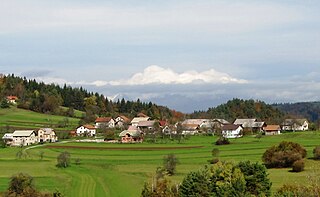
Vodice is a settlement in the Municipality of Vodice in the Upper Carniola region of Slovenia, just north of Ljubljana. In addition to the main population center of Vodice, the settlement includes the hamlets of Gornji Konec, Na Vasi, Lokarje, Jegriše, Mesto, Zaprice, and Pusence.

Dolenje pri Jelšanah is a village north of Jelšane in the Municipality of Ilirska Bistrica in the Inner Carniola region of Slovenia, next to the border with Croatia. The settlement includes the hamlets of Dolnji Kraj, Gornji Kraj, and Vrh Žloštajna.

Drenovec pri Bukovju is a settlement in the Municipality of Brežice in eastern Slovenia. It lies in the hills above the right bank of the Sotla River, northeast of Bizeljsko, on the border with Croatia. The area was traditionally part of Lower Styria. It is now included with the rest of the municipality in the Lower Sava Statistical Region. The settlement includes the hamlets of Gornji Drenovec, Lipovec, Trnje, and Gornja Vas.

Hrastje pri Cerkljah is a small village northwest of Cerklje ob Krki in the Municipality of Brežice in eastern Slovenia. The area was traditionally part of Lower Carniola. It is now included in the Lower Sava Statistical Region.

Prapreče pri Šentjerneju is a settlement in the Municipality of Šentjernej in southeastern Slovenia. The entire municipality was traditionally part of Lower Carniola. It is now included in the Southeast Slovenia Statistical Region. It includes the hamlet of Gmajnica.

Bojanja Vas is a village in the Municipality of Metlika in the White Carniola area of southeastern Slovenia, next to the border with Croatia. The entire area is part of the traditional region of Lower Carniola and is now included in the Southeast Slovenia Statistical Region.

Boršt is a small settlement on the left bank of the Kolpa River in the Municipality of Metlika in the White Carniola area of southeastern Slovenia. The entire area is part of the traditional region of Lower Carniola and is now included in the Southeast Slovenia Statistical Region.

Jugorje pri Metliki is a small settlement in the Municipality of Metlika in the White Carniola area of southeastern Slovenia. The entire area is part of the traditional region of Lower Carniola and is now included in the Southeast Slovenia Statistical Region.

Gornji Suhor pri Vinici is a village on the route from Dragatuš to Vinica in the Municipality of Črnomelj in the White Carniola area of southeastern Slovenia. The area is part of the traditional region of Lower Carniola and is now included in the Southeast Slovenia Statistical Region.

Grič pri Dobličah is a settlement southwest of Dobliče in the Municipality of Črnomelj in the White Carniola area of southeastern Slovenia. The area is part of the traditional region of Lower Carniola and is now included in the Southeast Slovenia Statistical Region. Hamlets of the village includes Dolnji Grič, which comprises the village core, and Gornji Grič, as well as Vidoše and Kralji. Vidoše has only a few houses along the road from Bistrica to Mavrlen. Vidoše was formerly a hamlet of Doblička Gora.

Lavrica is a settlement in central Slovenia. It lies southeast of the capital Ljubljana in the Municipality of Škofljica. The railway line from Ljubljana to Novo Mesto runs through the settlement. The municipality is part of the traditional region of Lower Carniola and is now included in the Central Slovenia Statistical Region. It includes the hamlets of Daljna Vas, Babna Gorica, Srednja Vas, and Sela pri Rudniku.

Veliki Lipoglav is a small settlement in the hills southeast of Ljubljana in central Slovenia. It belongs to the City Municipality of Ljubljana and is part of the traditional region of Lower Carniola. It is now included with the rest of the municipality in the Central Slovenia Statistical Region.

Tenetiše is a settlement on the right bank of the Sava River east of Litija in central Slovenia. Traditionally the area was part of Lower Carniola and is now included with the rest of the Municipality of Litija in the Central Sava Statistical Region.

Gorenja Vas pri Šmarjeti is a village immediately west of Šmarjeta in the Municipality of Šmarješke Toplice in southeastern Slovenia. The area is part of the historical region of Lower Carniola. The municipality is now included in the Southeast Slovenia Statistical Region. The settlement includes the hamlets of Mevce to the northwest, Podkrajec to the north, and Dolina, Hrib, and Ravnik to the west.

Zavinek is a small settlement south of Škocjan in the traditional region of Lower Carniola in southeastern Slovenia. Within the Municipality of Škocjan, it belongs to the Local Community of Škocjan. The area is part of the Southeast Slovenia Statistical Region.

Tlake is a settlement in the Municipality of Grosuplje in central Slovenia. It lies west of Šmarje–Sap on the road to Škofljica. The area is part of the historical region of Lower Carniola. The municipality is now included in the Central Slovenia Statistical Region. The settlement consists of two parts: Spodnje Tlake and Zgornje Tlake.

Bukovica is a village in the Municipality of Ivančna Gorica in central Slovenia. The area is part of the historical region of Lower Carniola. The municipality is now included in the Central Slovenia Statistical Region. It includes the hamlets of Brezovec, Cerovec, Gornji Vrh, Potok, and Ukajdol.

Gabrje pri Stični is a settlement just north of Stična in the Municipality of Ivančna Gorica in central Slovenia. The area is part of the historical region of Lower Carniola. The municipality is now included in the Central Slovenia Statistical Region. The settlement includes the hamlets of Kurja Vas, Potok, Pungrt, and Nograd.

Laze pri Boštanju is a dispersed settlement in the hills south of Boštanj in the Municipality of Sevnica in central Slovenia. The area is part of the historical region of Lower Carniola. The municipality is now included in the Lower Sava Statistical Region. It includes the hamlets of Rekštanj and Zapuže.














